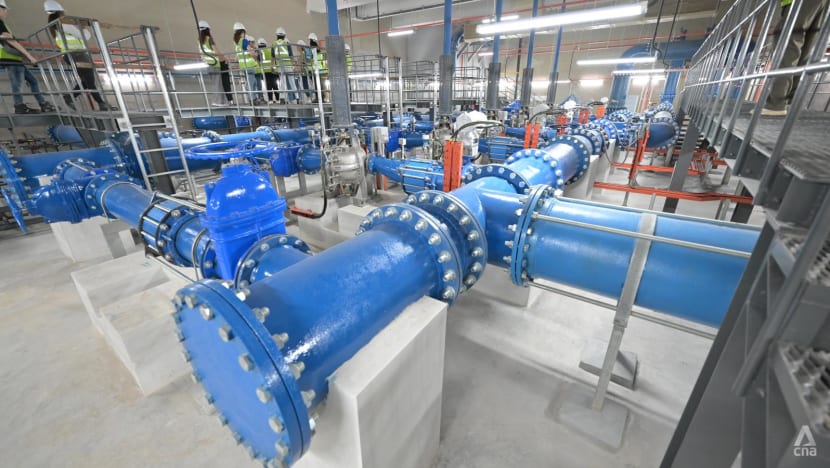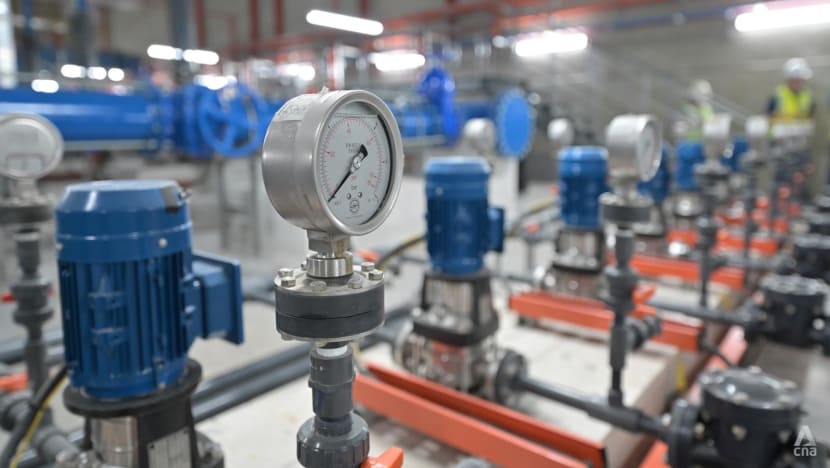Singapore completes first underground service reservoir, located under Bidadari park
The surface footprint of the Bidadari Underground Service Reservoir is about a third of the area taken up by a typical service reservoir of similar capacity.

Bidadari Underground Service Reservoir water tank. (Photo: CNA/Raydza Rahman)

This audio is generated by an AI tool.
SINGAPORE: Deep beneath a park in Bidadari lie two vast chambers with grey concrete walls, each accessible by a flight of steps.
With a depth of about 6.5m, the twin vaults are connected to an adjacent room full of pipes and shafts that supply an entire estate with potable water.
It is the first underground service reservoir in Singapore, constructed earlier this year. While one of the chambers was empty when CNA visited on Jun 14, the facility will serve 8,800 households in Bidadari when fully operational by the third quarter of this year.
With two water tanks able to hold a combined equivalent of three Olympic-sized swimming pools of potable water, the facility lies directly underneath a public park in the new estate, on the site of the former Mount Vernon Columbarium.
The development was announced by Minister for Sustainability and the Environment Grace Fu on Wednesday (Jun 19) at the opening of this year’s Singapore International Water Week and CleanEnviro Summit Singapore.
The events are expected to draw more than 20,000 people from around the world.
In her opening speech, Ms Fu said Singapore has invested heavily in the construction of canals, drains, and reservoirs to manage stormwater runoff effectively.
“Where possible, we integrate them into our urban environment so that they can double up into spaces for functional and recreational purposes,” she said.
She noted that the Bidadari Underground Service Reservoir - the country’s first to be built on low ground - will be integrated with Bidadari Park to optimise land use.
“It will help fortify water supply to meet the water demand of present and future Bidadari residents,” said the minister.

MAXIMISING LAND USE
Singapore’s land scarcity was a reason the national water agency PUB chose to build downwards.
The surface footprint of the Bidadari underground service reservoir is about one-third that of a typical service reservoir of similar capacity.
The facility lies almost entirely underground, with only the pumping station occupying a plot of about 700 sq m - just over one and a half basketball courts - within the Bidadari estate.

Integrating the land above the water tanks with the adjacent Bidadari Park has saved PUB about 1,500 sq m.
“One of the reasons we are considering constructing underground service reservoirs is that it is not easy to find available locations to construct the high-ground service reservoirs in land-scarce Singapore,” said Ms Esther Khoo, deputy director of PUB’s water supply network department.
“Also, it is challenging to find space to lay our accompanying pipelines in the increasingly congested underground space.”
PUB currently operates over 10 such service reservoirs, including NEWater service reservoirs for industrial customers.
Service reservoirs store drinking water from PUB’s treatment plants before it is piped to consumers, and serve as a buffer against daily fluctuations in water demand.

Existing service reservoirs are built on high ground to maintain stable and consistent pressure throughout the network, so that water flows to customers via gravity without the need for pumping.
Ms Khoo explained that unlike conventional high-ground service reservoirs, the underground facility is located within the new estate itself, and is designed to ensure that the water demand in Bidadari is met by boosting water pressure during peak periods when demand is high - from 6am to 10am, and 6pm to 10pm daily.
The Bidadari underground service reservoir supplies water to homes via up to five centrally operated pumps.
Ms Khoo said the Bidadari facility has been constructed and is currently undergoing testing and conditioning of the tanks, before becoming fully operational by the third quarter of 2024. The facility will serve 8,800 households.
Mr Alfred Chan, PUB’s lead engineer for the construction of the Bidadari project, said the agency saw the opportunity and potential to testbed the concept of an underground model during the master planning stage of the new Bidadari estate.
“Thus, we proposed the concept to URA (Urban Redevelopment Authority), HDB (Housing and Development Board) and NParks, which could be integrated as part of the estate's infrastructure,” said Mr Chan.

CHALLENGES OF GOING UNDERGROUND
During off-peak hours, the Bidadari underground service reservoir is filled up with water from upstream high-ground service reservoirs, to ensure an adequate supply for subsequent peak-hour usage, explained Mr Chan.
Operations at the Bidadari facility are fully automated and can be monitored from PUB’s Joint Operations Centre, he added.
Building Information Modelling technology was also used for the 3D-modelling and construction of the Bidadari underground service reservoir.
Compared to conventional 2D models, the technology helped PUB visualise the layout of the new facility’s structure more efficiently, especially with complex layers of pipeworks involved.

Construction of the Bidadari facility started in January 2020 and was scheduled to be completed by June 2022, said Mr Chan.
“However, there was a delay due to shortage of manpower and construction materials during the COVID-19 pandemic,” he noted, adding that construction was eventually completed in January this year instead.
The team also faced multiple challenges in constructing the underground service reservoir’s large water tanks.
“For instance, to transport machinery and materials to the basement, which is 9m below ground level, we worked together with the contractor to implement a longer spiral ramp around the worksite,” said Mr Chan.
Wet weather and intense rainfall also caused water to pool at the construction site, so the team required extra time for drainage, he shared.
Detailed coordination was also required across both the planning and construction phases within PUB, as well as with other government agencies overseeing the adjacent park’s development, such as HDB and NParks, noted Mr Chan.















